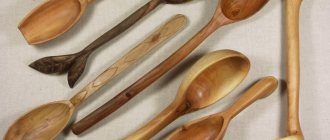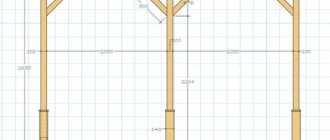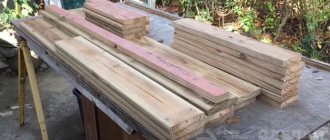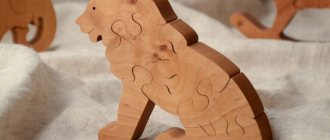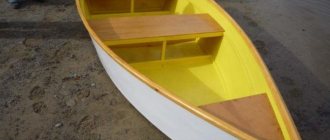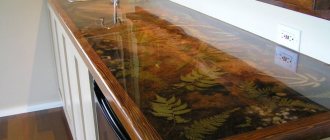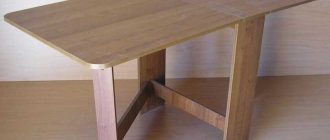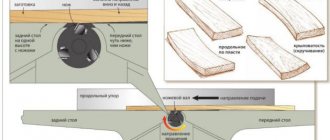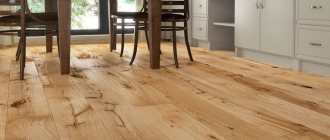How do you get a croaker?
Freshly cut trees arrive at the sawmill. First of all, they go to the peeling machine, which cuts off the slab. It can be of different thickness and width. Depending on this, it is sorted into:
- business (wide and thick over 35 mm, suitable for the manufacture of small and medium-sized products for construction and household use);
- wood waste is small waste that is used for the production of heating oil or direct disposal in furnaces.
In addition to the size of the scraps, the method of sawing them is taken into account:
- cutting into a shaft - you get 2 wide boards;
- lumber - 4 small width bars come out.
Depending on further use, the cuttings are treated with antiseptics, the cut surface is leveled, and the bark is removed.
Heat treatment, which is carried out by some large woodworking sawmills, will help to avoid the problem of parasites and relatively low strength. The croaker is placed in heat chambers, where the insects are dried and burned under the bark. True, such lumber costs more than usual.
We make a fence from slabs with our own hands
The construction of such a structure is in many ways similar to the creation of fences from edged, unedged boards, or picket fences. Therefore, we will not go into detail at some stages so as not to repeat ourselves.
Marking, foundation
After developing a construction scheme and calculating costs, selecting a location, and cleaning the site, you should proceed to marking.
Since the fence will not create a large load on the ground, it is enough to equip a columnar foundation. But sometimes a belt one should also be used if the slab is combined with heavier materials (metal, stone, brick).
The type of base largely depends on the selected raw materials for the pillars. In the version with a fence made of slabs, pillars made of wood or metal are considered optimal.
Preparing material for fastening
To begin with, the selected planks are cleared of bark. This is a mandatory procedure, since there may be insects under the bark that spoil the wood and significantly reduce its service life.
This is done this way:
The cleaned elements are passed through with sandpaper, but it is more effective to do this with a grinding machine or an electric drill with an attachment. The surface will take on a neat appearance.
Treatment with protective agents
The next step is the application of a special composition (antiseptic), which penetrates deep into the structure of the wood and creates a film on the surface, protecting the raw material from moisture, the development of fungus, and insects.
A separate category is fire retardants, that is, products that make wood resistant to fire.
Thanks to the treatment, the service life of the slab increases to 15 years.
Drying time is a day.
Tips for choosing a suitable protective agent against rotting, the procedure for processing wood.
Installation of slab
This is done in two ways:
- Horizontally. Simplified fastening option. The boards are nailed or screwed directly to the supports. Material consumption is minimal. Nails and screws should be treated with an anti-corrosion compound. Disadvantage: low strength and stability of the structure.
- Vertical. Outwardly it resembles a fixed picket fence. Two horizontal veins (logs) are mounted to the supports: one 20 cm from the top, the other 20 cm from the bottom. The obapole is fixed vertically. The material consumption is large, but elements of different widths and thicknesses are suitable.
In addition, in both methods, the boards can be fastened either with or without a gap.
Other nuances of installing wooden elements to the structure are described in detail in this article: “Wooden fence on metal poles.”
Decorating a finished fence
For decorative and protective purposes, it is best to paint the fence, but the coating will have to be renewed every 2-3 years.
An article about choosing paint and the process of applying it to a wooden surface.
The fence will look impressive if you add the following elements:
- gable rain canopy along the entire perimeter;
- flower pots hung on sections;
- carved contours;
- cut round coins from wood, nailed to the fence outside;
- Interesting sawn ends of both floors.
An alternative to painting is brushing, tinting or varnishing the material.
From the remains of the slab you can make a small hedge for a flower bed.
If you use your imagination, even with minimal investment you can turn an ordinary fence into a unique, beautiful structure.
More about varieties
Although commercial slabs and wood slabs are waste, they are not disposed of in a landfill, but are used in a useful way.
Wood-burning is a thin slab with an uneven thickness of up to 35 mm. Such a cut is almost impossible to use for the manufacture of any products, so it is burned in the furnaces of furnaces and boilers. In addition, this material is much cheaper than ordinary firewood!
Business is, rather, a semi-finished product. What can be made from such a slab:
- thin boards;
- lining;
- various wood products for the household (cutting boards, kitchen shovels and snow shovels, etc.);
- construction and finishing elements;
- formwork;
- rough floors;
- landscaping of a garden plot, etc.
Decorating the ceiling with wood: features, types, advantages and disadvantages of wooden ceilings
Despite its high cost, the arrangement of wooden ceilings is currently rapidly gaining popularity. Wooden materials on the modern market are represented by a significant assortment, ranging from cladding options (slats, panels, bars, boards, beams) to all kinds of wood (pine, beech, mahogany, etc.). Wooden ceilings made according to an exclusive project are rightfully considered the standard of quality, respectability and well-being.
Features of wooden ceilings
Creating a ceiling in the conditions of modern possibilities allows it to be carried out in any acceptable solution, for example, tension options, aluminum, adhesive and many others. But, among this diversity, only the wooden type has no closest competitors in most properties. Of course, coffered (solid) ceilings look the most respectable and elegant, but other wood derivatives (plywood, fillets, etc.) look no less aesthetically pleasing.
Wood is a very accessible and widespread material, easily amenable to any type of processing. In addition, it provides high-quality thermal and good sound insulation, while adding comfort to the room. Of course, there are opponents of this type of finishing, accusing it of being excessively expensive. But most famous designers do not agree with this, explaining that the accompanying materials needed to process the ceiling surface are expensive: varnish, putty and primer mixture.
There is also an opinion that wooden ceiling decoration is intended only for cultural and entertainment premises, country houses, exclusive offices, cottages, etc. One may also disagree with this, since a competent choice of a suitable material can significantly improve the ambiance of any living space.
It is worth dispelling another “wrong stigma” that dictates the use of wood finishing exclusively in dry rooms - hallways, bedrooms, living rooms, etc. Modern knowledge, processing compositions, innovative technologies provide optimal opportunities for using wood in finishing bath rooms, not to mention about bathrooms, attics and kitchens.
Several recommendations for choosing material
To ensure that finishing the ceiling does not cause a feeling of disappointment, first of all you need to choose the right material. To do this, experts suggest focusing on the following recommendations:
Croaker or board?
It seems that few people think about the fact that in some cases it is enough to use a cheaper and lighter slab than ready-made boards. Why sometimes you should choose primary trunk cuts:
- light weight;
- low cost of a business slab compared to the price of a regular board;
- the bark is no less durable than the wood itself;
- During finishing and construction, an important bonus will be the unusual decorative appearance of the bark.
Products made from slab can be both functional (barn walls, fences) and decorative (surface cladding).
True, the material has several disadvantages:
- Parasites often live under the bark, so to use the croaker it is necessary to carry out disinfestation;
- If necessary, you will have to remove the bark yourself. Fortunately, this process is not particularly labor-intensive, but it will still take some time.
Options for slab fences for a summer cottage
The photo below shows a wood-type pine fence with vertical fastening of elements. The posts and logs are made of wood. The dies are partially cleared of bark to preserve their original appearance. For decorative purposes, the upper part of the planks is pointed, which roughly resembles an old Russian fence.
The image shows an example of a double-sided horizontal fence. The obapole with uneven edges is neatly arranged together. The good thing about this design is that what is happening in the yard is not visible; the structure is equally beautiful on both sides.
Disadvantage: increased material consumption. The upper part of the fence is covered with a metal canopy. The boards are painted in the color of natural wood and varnished. There are flower pots on each section.
Croaker in construction
Currently, croaker as a building material is often used for:
- installation of houses;
- construction of outbuildings (storages, sheds);
- installation of gazebos and canopies.
The slab will not make a permanent house; it is, rather, a cladding material. There is an option for arranging a summer house without the possibility of a winter stay. The fact is that the slab boards are uneven in width and thickness, making it very difficult to maintain the tightness of the walls. In addition, to keep the rooms warm, it is necessary to create walls of sufficient thickness, which is very difficult to achieve using a side cut of a log.
A slab barn is the most optimal way to build a utility structure. If you do not need to create airtight walls, then it is reasonable to use such boards.
General installation principle:
- Wooden posts are driven into the ground. You can make screw piles and fix support posts on them. They are mounted in the corners of the building and at a distance of 2-3 meters around the perimeter.
- Horizontal guides are nailed to the posts, to which the vertical slab will be attached. The load-bearing boards are fixed in the upper belt, in the middle and at a distance of 20-30 cm from the ground.
- The slab boards are fastened to nails vertically close to each other or at a short distance.
A similar work algorithm is followed when building a fence from slab. By the way, if you like the horizontal direction of the boards, then neglect the installation of support guides, fixing them between the racks.
Another trend is a sauna made of slabs. As in the case of building a house, when installing a bathhouse you cannot use only a slab - it must be hot in the steam room, this requires sealed walls of sufficient thickness. But nothing prevents you from making a waiting room or entrance group. In addition, slab finishing inside and outside is gaining popularity.
A gazebo made of slab looks unusual and cozy. It can be closed or open. In a gazebo, the tightness of the walls is not important - they will protect you from the wind and sun even with the boards not pressed tightly against each other.
Also, lumber is useful when constructing a roof - a slab 2-3 cm thick can be used for installing sheathing under corrugated sheets, flooring under tiles.
How to use on the facade
Wooden siding of a house will cost a very considerable amount if you use high-quality and expensive wood for this. However, in the case of slab, the costs will be the lowest possible. You just have to take into account that the appearance of the surface will differ from the usual one and not everyone will like it. In addition, this type of wood is usually not subjected to any processing in production and you will have to dry it at least a little, and then coat it with antiseptics so that pests do not damage the skin later.
In principle, everything will be quite simple. It is necessary to remove the bark from the wood - the most labor-intensive and time-consuming process. After this treatment, it will become much more beautiful. Having coated all the boards with antiseptics, they should be left until completely dry. If necessary, the procedure can be repeated. Now you need to choose the installation method: horizontal or vertical. It depends entirely on your preferences.
Slats are stuffed onto the base or attached in another way, which will become the basis for attaching the boards. The base itself should also be treated with an antiseptic. The slats are fixed on the base across the laying of the slab. It is important that there is at least a couple of centimeters of free space between the created sheathing surface and the wall. It is necessary to remove excess moisture from the walls. The actual finishing of the facade of the house with a slab begins - it is nailed or attached in any other way to the slats that were mounted earlier.
Advice: for all installation work, it is better to use steel nails made of stainless steel rather than galvanized ones. They will cost more, but will not give rust stains later. Galvanizing usually peels off easily when driving a nail and it begins to rust.
Laying can be done overlapping, as everyone usually does, or end-to-end. However, for the latter option you will need boards that can fit together tightly. In the case of sawing waste, it is almost impossible to find such even parts, therefore, the best option is overlap.
There are two methods: “herringbone”, when the part located on top covers the top of the bottom with only one edge and a kind of ladder is obtained, or in a checkerboard pattern, when the top board is overlapped with the edges of two adjacent ones. The first method is for horizontal laying, and the second is suitable for all types of cladding. Having completely covered the wall, it needs to be treated with paint or stain to give the wood the desired shade and you can move on to the next wall.
What is a croaker: photo, description
Croaker is waste, part of a tree trunk when sawing logs. When processing timber or boards, the workpiece is cut on four sides, resulting in a rectangular cross-section. The material, on the one hand, preserves the natural surface of the wood, and on the other hand has a cut plane. It finds application in many areas of industrial activity.
Types of lumber
Waste sawn material comes in two types:
Industrial wood has a thickness of at least 35 mm. Structures of various shapes are made from it. Lumber can be unprocessed - with bark. Wood, cleared of bark, is used for cladding building structures.
Firewood lumber is processed. Some boards are used as firewood. Wood chips are made from it. Briquettes are made from wood chips for lighting stoves and boilers. Wood chips are used to sprinkle paths in the garden and strengthen the soil foundation in greenhouses and conservatories. Firewood is shown in the bottom photo.
How to produce
Waste lumber is obtained by processing tree trunks. In industrial conditions, logs are sawed using complex machine equipment with four saw blades. Numerical control is configured in such a way that the logs are cut simultaneously from four sides. The required thickness of the slab and the maximum length of the cut are set.
There are double-sided longitudinal planing machines. First, two opposite sides of the trunk are processed, then the workpiece is rotated 90˚ along the longitudinal axis and the separation of the outer layer of the tree continues.
The trading network has different types of sawing machines for large workshops. It is beneficial to keep the equipment for work in the household.
Kinds
The value of business waste lumber depends on the type of wood being processed. For example, birch, spruce, and aspen boards are used in construction as auxiliary materials.
Products made from larch, oak and other valuable wood species are expensive. Such raw materials are classified as the highest category. It is used as a finishing material.
Application
Industrial lumber is used as construction timber for the manufacture of:
- fences and fences;
- registration of personal buildings;
- formwork;
- roofs;
- pallets;
- garden furniture;
- gazebos;
- designer furniture in loft style;
- cladding of enclosing structures;
- linings;
- crafts.
Fences and enclosures
Fences and enclosures made from wood waste provide owners of private farms with significant savings. Timber does not require special conditions for storage and construction. The slab is nailed in a vertical position to the transverse slats between the support posts. It is placed horizontally, filling the openings between the racks. The croaker, cleared of bark, is impregnated with antiseptics and covered with varnish or stain.
Low fences define the boundaries of plots of land planted with different crops. The boards can be dug into the ground by first wrapping their lower part with roofing felt or roofing felt. This type of fencing can last for a long time.
Formwork
It is advantageous to use waste lumber as formwork. It can be made very quickly for small monolithic foundation structures from slabs. Wood-burning lumber is suitable for making fences for liquid concrete. The removed formwork is used as fuel for lighting stoves, boilers and fireplaces.
Roof
Supporting structures made from slabs under roof cladding boards significantly reduce the cost of construction. The load-bearing capacity of such a roof is in no way inferior to structures made from factory-made profiles.
Pallets
The horizontal planes of the pallets, made from slabs, are connected with pieces of timber and nailed. Such boards are not used in industrial production. Pallets are made for the needs of private households in their workshops. They are convenient for storing building materials and barrels of salting.
Country furniture
The backs and seats of garden benches are covered with bark-free material. To protect the wood from exposure to the atmosphere, it is coated with varnish for exterior use.
From waste wood they knock together bases for sleeping mattresses and make bedside tables. At the dacha, interior partitions are made from boards.
Gazebos and canopies made of slab
Gazebos and canopies, sheathed inside and outside with slabs, have an original, exotic look. The frame of the structure is a rectangular structure, the main element of which is the slab. To ensure rigidity of the structure, boards with a thickness of at least 40 mm are used. The frame of the gazebo is sheathed with a slab - it does not bear the main load.
The roof of the gazebo is covered with a slab. Although this is not necessary, traditional roofing materials are usually used.
Designer furniture in loft style
Recently, the loft style in interior design has become popular. The fashion trend has affected furniture. It is better to make countertops from oak boards or larch. You can use lumber from other types of wood.
Select wood with a uniform profile. The bark is removed, sanded and varnished. Strongly protruding branches are cut off. Gaps between boards and uneven surfaces are filled with epoxy resin mixed with fluorescent powder. A luminous table will decorate the veranda, country kitchen or living room.
Cladding of enclosing structures
Finishing walls and ceilings with slabs made of valuable wood creates an atmosphere of closeness to nature inside both residential and public premises. A sheathing of timber or slats is installed along the planes of the fences. The choice of sheathing profile depends on the thickness of the slab. The boards are nailed with small nails, driving them into the edges.
Cleaned boards are used to decorate walls and ceilings in rooms with high humidity levels (baths, saunas). Walls covered with coniferous boards (pine, spruce) constantly spread the aroma of resin, which acts in the same way as a disinfectant.
Lining
It is quite rare to make slab lining with your own hands. It all depends on the quality of the source material. The thicker the boards, the greater the chances of producing high-quality lining. The height of the cross-section of the wood should allow the raw material to be sawed so that grooves and tenons with a thickness and width of at least 10 mm are obtained. Otherwise, the wall cladding will turn out fragile and unreliable.
The surfaces of the walls and ceilings in the steam room of the bath are covered with lining. The products are used to cover rooms both inside houses and outside facades. The boards are fastened to the wooden sheathing with clamps or nailed.
Crafts
Among the waste from sawing timber there will always be short pieces of slab. You can cut out crafts from them.
Various openings in the fences indoors are framed with a figured slab. A coat rack looks beautiful on the wall, the base of which consists of a row of slabs with hooks for clothes.
Craftsmen use waste lumber from valuable wood to make various souvenirs.
Advantages
The advantages of the slab are as follows:
- The cheapest lumber. Its use as load-bearing elements brings significant cost savings when constructing lightweight buildings.
- The low weight of the boards when constructing small objects allows you to create cheap foundations.
- Cladding with slabs does not require additional finishing of building structures. Walls covered with decorative wood carry an aesthetic value.
- Barked surfaces are varnished or painted, which gives the furniture a special appeal.
- The ease of installation of lumber does not cause difficulties when carrying out facing work.
- Wood waste is widely used in the manufacture of various products - from parquet to the design of accent walls.
- Using industrial wood as lining will allow you to avoid unnecessary costs for purchasing a factory profile.
derevo-s.ru
